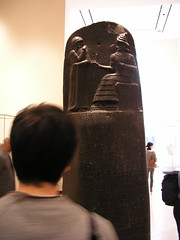 Image by carmen_seaby via Flickr
Image by carmen_seaby via FlickrNews out of Haaretz.com in Israel: A small clay tablet has been discovered by archaeologists in Israel while escavating a site called Tel Hazor. The tablet is approximately 3,700 to 3,800 years old and has key words that remind experts of Hammurabi's famous law codex. The tablet uses Akkadian cuneiform, the international language of diplomacy during that ancient time. Here is a link to the Haaretz wire story:
http://bit.ly/94sYgv
Hammurabi was the sixth king of Babylon, considered the first king of the Babylonian Empire and the ruler of all of Mesopotamia. He is famous as the first law giver and his Hammurabian Code. Many experts believe that key laws and moral principles found in the Jewish Bible were strongly influenced by Hammurabi.
Was Hammurabi the first law giver? The first in recorded history to this date, yes. But what if there were earlier law givers? Maybe not kings, but influential "law clerks", sojourners -- perhaps people on a quest to save a future Western civilization that had yet to significantly develop. What if these people "planted the seeds" that eventually influenced those who helped create Hammurabi's famous Code? And what if those influencers somehow had an insight into today's modern American society?
Well, I've given enough hints! The new novel, Gettysburg Passage, ISBN 978-0-615-39102-1 by John Callahan, will be published by Amazon in mid August. The plot deals with Americans who confront a series of mysterious events that may have some powerful relation to earlier civilizations, even pre-dating good old Hammurabi.











